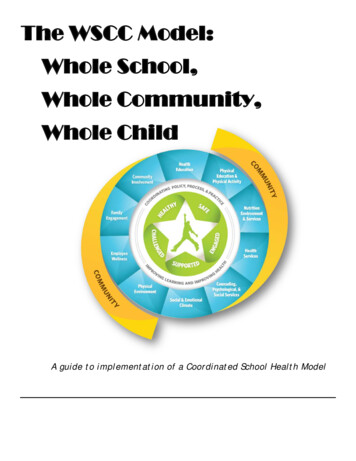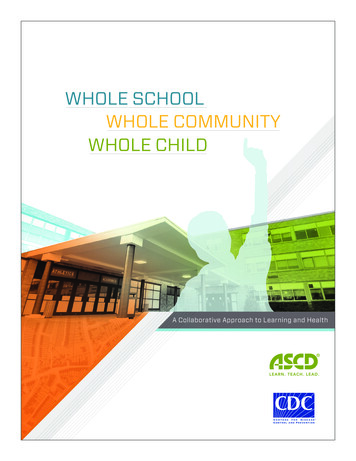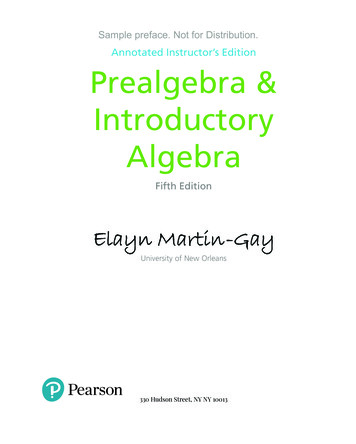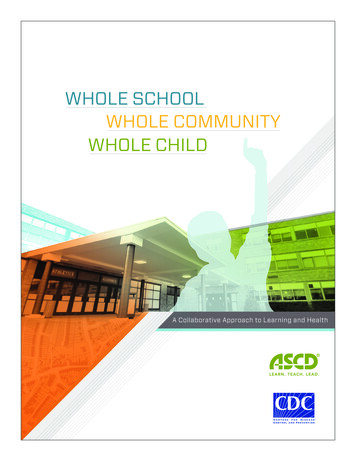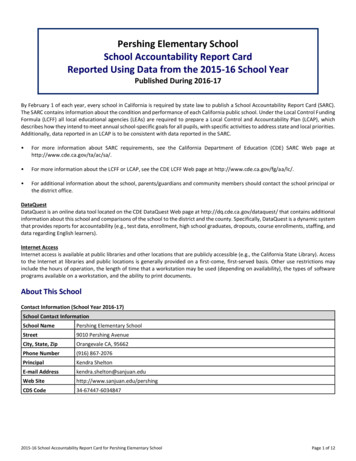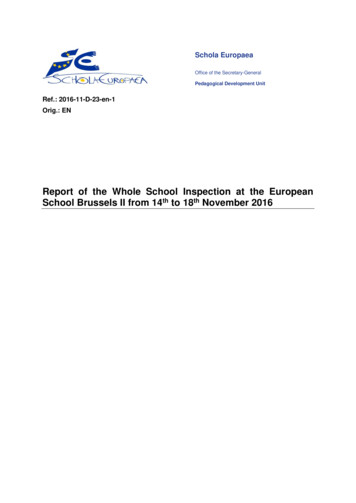
Transcription
Schola EuropaeaOffice of the Secretary-GeneralPedagogical Development UnitRef.: 2016-11-D-23-en-1Orig.: ENReport of the Whole School Inspection at the EuropeanSchool Brussels II from 14th to 18th November 2016
TABLE OF CONTENTS1.INTRODUCTION . 32.SUMMARY OF MAIN FINDINGS AND RECOMMENDATIONS . 43.FINDINGS . 52016-11-D-23-en-12/11
1.IntroductionName of school: ES Bruxelles IIDate:14-18 November 2016Inspection team:Management of the school:H.T. Coelho (coordinator), T. Huisman,A. Coenen, B. Goggins, P. Hess, L. vdBosch, Y. GammelgaardS. Sharron, J. Schmelz, J. ArnedoThe inspection was carried out according to the document ‘Common framework for wholeschool inspections in nursery, primary and secondary cycles (ref: 2010-D-139-en-9)’.Prior to the inspection a school self-evaluation form, following the structure of the criteria andindicators for whole school inspections, was sent to the school.The school forwarded the following documents to the inspectors, which were analysed beforethe school visit: the schools’ self-evaluation form: Multi Annual School Plan Annual School PlanThe inspection activities included: A presentation by the school management Meetings with: students, coordinators (section, subject, level, support, pedagogical,transition), parents representatives, CDP/CDC representatives, PAS, PrincipalEducation Adviser, management Lesson observations in all the language sections and of different subjects6 lessons in nursery cycle22 lessons in primary cycle44 lessons in secondary cycle Analysis of relevant documents: several policy documents, planning documents,actions plans, minutes of meetings, evaluation documents, portfolios, projects, Bacdocuments, Educational Support documents and files. Feedback meeting with the management2016-11-D-23-en-13/11
2.Summary of main findings and recommendationsStrong points School ethos and atmosphere: pupils and teachers respect each other, national daysare celebrated, the school has implemented several projects to promote mutualrespect between cultures. Educational Support: In both cycles the care teams follow the framework of thesupport policy and perform their work in a dedicated manner. The school has createda caring environment with a strong focus on pastoral care.Challenges Quality assurance: the management team needs to have a common perspective forthe medium term and long term future of the school as a whole. This perspectivemust be presented in the MASP. The cyclical process of school self-evaluation mustbe more evident across the whole school. Assessment and achievement: on a general level the school is implementing theEuropean Schools policy on assessment but the school lacks coherent andconsistent guidelines on evaluation and assessment of progression including the selfassessment of pupils. As a result it is unclear how the school will utilise assessmentto improve the quality of teaching and learning. The school has made progress in several areas by putting organisational structures inplace (for example educational support and transition), however the separate areasshould be connected and more focussed on teaching and learning.General points The pupils are the central focus of a very committed staff. The school has managed to deal with the restrictions imposed on them by the lack ofspace on campus although this has now reached a critical point. Office 365 which has been very successfully piloted and developed in primary schoolsupports teaching and learning, organisation administration and communication. Thisis an exemplar for the whole system. It would be beneficial to share the excellent practices that are present in the school. Management should operate as a single unit to create a dynamic environmentfocussed on improving the quality of teaching, using their diversity as strength. Two of the four recommendations from the follow-up of the previous WSI are fulfilledto a high standard in primary and one at least partially. While some progress hasbeen made in secondary the recommendations have not been fulfilled. Management should take firm decisions and implement them. Communication between all stakeholders should be more open and decision makingprocedures should be more transparent across the whole school. The self-evaluations of both primary and secondary demonstrated a somewhatsuperficial reflection. A more in-depth analysis with the involvement of stakeholderswould improve the value of the self-evaluation process.Recommendations Within the general vision of the European Schools the management should establisha coherent set of educational principles and purposes that create a road map for thefuture of the whole school. Management should develop a whole school self-evaluation process involving allstakeholders and use this as a basis for the existent and future MASP. Management should create coherent and consistent guidelines on evaluation andassessment of progression including the self-assessment of pupils.2016-11-D-23-en-14/11
3.FindingsWhole School Inspection - Evaluation FormName of School: European School Bruxelles IIDate: 14-18 November 2016Area of EvaluationCriterionIndicatorsEvaluationNA PA SA FAI. Management and OrganisationNA PA SA FAI.1 The school management ensures teachers are up-to date withcurrent pedagogical developments both in terms of subjectcontent and methodology There is evidence of structured continuous professional developmentand dissemination of information.I.2 The school management enables and encourages cooperationand coordination within and between sections, subjects andcyclesXX There is evidence of teachers exchanging professional experiences andexpertise between levels, sections, schools, etc.I.3 The school has guidelines for transition from nursery toprimary and from primary to secondaryX There is evidence of procedures for transition of information from nurseryto primary and from primary to secondary (meetings, visits, projects, etc.)I.4 Coordinators (middle managers, cycle/level/subjectcoordinators) have an organisational and pedagogical rolex There are job descriptions for the role of coordinator. There is evidence of meetings, projects, etc.I.5 The school management ensures an effective use of teachingtimex Timetabling ensures an equitable distribution of subject time through the week/half term. Measures are taken to make best use of teaching time, including replacements. There are guidelines on homework.Conclusion:The manner in which the management of nursery/primary cycle enables and encouragescooperation and coordination between sections, subjects and cycles is highly praiseworthy.While progress has been achieved by secondary, sharing the practice and experience ofnursery/primary would be beneficial to the whole school community.Management is aware of the importance of job descriptions, however not all coordinator rolesin secondary cycle have up-to-date job descriptions.2016-11-D-23-en-15/11
The introduction of the study room is a very positive step forward in secondary cycle.The transition process is very well organised but could be further improved by mutual classvisits followed by discussion on content and pedagogical-didactical approaches betweencycles.II. School Ethos and ClimateNA PA SA FAII.1 A European Context is established in order to fostermutual understanding and respect for diversity in amulticultural setting The totality of the European dimension is integrated and implementedacross the school and in teachers’ planning. Teachers plan and work together across language sections. Pupils work together across language sections when appropriate.II.2 Pupils’ cultural identity is confirmedXX There is provision for mother-tongue/dominant language teaching. There is evidence of celebration of national festivals and reference tonational current affairs.II.3 The social climate reflects the aims of the school, toencourage successful learning and to foster tolerance andmutual respectX There is evidence of-Mutually respectful relations between members of the school community.-Knowledge of and respect for the school rules.-Consistent and rapid response to conflicts, particularly to bullying and todiscrimination of any kind, by pupils or teachers.-Communal events which bring together pupils and teachers (and parents) fromdifferent language sections.-Positive encouragement of good behaviour and consistent response to inappropriatebehaviour. Pupils have access to, and use, facilities for personal support and when necessary,complaints.II.4 Education for sustainable development is fostered in theschoolX Projects / activities are carried out focusing on sustainable development. Students are involved in planning, accomplishment and evaluation of projects / activities.Conclusion:There are noteworthy projects for sustainable development and social wellbeing. TheEuropean dimension is well developed and promoted with the full support of management.2016-11-D-23-en-16/11
III. Curriculum and PlanningNA PA SA FAIII.1 Teachers forward planning is up-to-dateX Long term and short term planning, based on the curriculum, is available.III.2 There is continuity and progression from year to yearX There is evidence of transfer of planning (meetings, documents, etc.).III.3 The planning within and across the sections is harmonisedX The school planning guidelines and templates are used.III.4 Individual needs of pupils are respected in planningX References are made to differentiated approaches and other teachingstrategies in the planning (caring for individual pupils’ needs, pair work,small group work, activity based work, use of ICT, etc.).Conclusion:In the follow-up report 2014 it was stated that ‘a whole school planning approach andharmonised templates should be a priority’. In primary all annual and period planning’savailable in Office 365 and there are agreements on topics that should be included.“Differentiation” is such a topic, but in a lot of cases only described in a very general way.In secondary there are no guidelines for planning.IV. ResourcesNAPASAFAIV.1 Human resources are efficiently managedX Teachers are appropriately qualified. Assignments of tasks are related to experience and expertise of teachers.IV.2 The school physical environment is appropriate forteaching and learningX There are an adequate number of appropriate sized rooms. Classrooms and public areas are clean, safe, tidy and are in good repair. There are displays of work and other materials in corridors and classroomsrelated to the European dimension.2016-11-D-23-en-17/11
IV. 3 A range of adequate equipment is availableX Sufficient resources are available to enable pupils to learn effectivelyin all areas of the curriculum. Resources are used effectively to implement the syllabi. There is an adequate supply of subject-related equipment. There is an adequate supply of ICT equipment in the classrooms. A library/multi-media centre is in place with an adequate rangeof relevant books and ICT materials.Conclusion:The school has been very creative in the way they use the available space. The outsiderecreational area has been significantly improved.The school does not have an adequate number of appropriate sized rooms. Consequentlysome spaces that were not originally designed as teaching space are currently used as such.In some cases this is limiting to the quality of education. Also there is not sufficient suitableindoor space for pupils during breaks.V. Teaching and LearningNAPAV.1 Teachers implement programs of work based on theirplanningSAX Lessons are planned, well-structured and relate to the syllabus. Teachers communicate the aims, objectives and competences to beaccomplished by their students. Teachers show knowledge of the subject and the European School syllabus. Culture, history and geography of different countries are integrated in theteaching and learning process. Cross curricular links are emphasised and a broader environment and contextare utilised.V.2 A variety of teaching and learning methods are employedappropriately by teachersX Teachers create an environment in which pupils can learn independentlyand collaboratively and support each other s learning. Teachers involve all pupils actively. The teaching when possible encourages awareness of broadenedcontext outside the classroom or the particular lesson. Teachers integrate ICT into their lessons.V.3 Pupils are active learnersX Pupils show an active learning attitude and involvement during their lessons. Pupils get feedback in order to improve their learning. Pupils are responsible for aspects of their own learning.2016-11-D-23-en-18/11FA
Pupils use ICT in learning.V.4 Teachers respect pupils' individual needs in theirteachingX Differentiation is taken into account in lessons (e.g. different content /process / product / learning environment), when appropriate in relationto pupils different learning strategies.V.5 Teachers show effective classroom managementX Teachers create a stimulating learning environment, including displaysof work or other materials. Teachers use resources effectively. Teachers use teaching time effectively.Conclusion:In the follow up report 2014 it is stated that “differentiated approaches in the planning andpractice of all teachers needs attention”. In the primary cycle some progress in the planninghas been observed, but differentiation is not reflected in the practice of teachers as much ascould be expected.In secondary very little variation in teaching and learning methods was observed in thelessons. In the primary good examples of cooperative learning were observed.VI Assessment and AchievementsNAPA SA FAVI.1 The school implements the European Schools policy onassessmentX Teachers apply the policy on assessment (e.g. Records of the pupils’ development inEarly Education; School Reports in Primary; Harmonised Examsin S5, Pre-BAC in S7). Teachers continually assess pupils’ progress (formatively and summatively). A range of different assessment methods is used to provide a good pictureof pupils’ competences, including knowledge, skills and attitudes.VI.2 Assessment methods are valid, reliable and transparentX Assessment is clearly related to the learning objectives. Information about learning objectives, assessment criteria, and time ofassessment is available for pupils. Records of pupils’ progress are maintained. Pupils’ results are analysed at individual, class and whole school level. Pupils’ attainments are communicated to their parents.2016-11-D-23-en-19/11
VI.3 Pupils develop the ability to assess their own workX Pupils’ self-assessment skills are developed by using a range ofdifferent strategies (portfolios, individual folders, questionnaires,copy-books, etc.).Conclusion:In the area of the portfolio the nursery/primary team has really made progress in establishing aharmonised approach. However self- and peer assessment should be more integrated in theday to day classroom practice. Some good practice could be further disseminated. In the followup report 2014 it is stated that ‘in the secondary cycle a review and reflection process in someareas of evaluation and assessment should be implemented and developed’. During the lessonsobserved this was not evident.VII. Educational Support (General, Moderate and Intensive Support)NA PA SA FAVII.1 The policy on the provision on educational support is respectedX The school has guidelines in accordance with the educational support policy. There are harmonised procedures in place to identify pupils with differentlearning needs. Individual Educational Plans are compiled, reviewed and updated. Support is monitored and its effectiveness is evaluated.VII.2 Human and material resources for support are in placeX The coordinators’ tasks and responsibilities are clear. Educational Advisers and Consultation and Support Personnel effectively monitorbehaviour and attendance and liaise regularly with classroom teachers on bothpastoral and academic matters. Confidential documents are properly maintained and stored. Support materials are available (ICT, national materials) and easy to access. Time allocation of support is transparent and flexible.Conclusion:The support is very well organised. The school guidelines respect the policy of the Europeanschools. There is room for improvement in the areas of transparency and flexibility.2016-11-D-23-en-110/11
VIII. Quality Assurance and DevelopmentNA PA SA FAVIII.1 A structure for quality assurance and development isimplementedX A systematic procedure for school’s self-evaluation is in place inwhich representatives of all stakeholders are involved at regular intervals.VIII.2 The school’ s vision, aims and objectives are outlined in theMulti Annual School Plan (MASP) and in the related Annual SchoolPlan (ASP)X The school has clearly stated its aims and objectives. The MASP and the ASP are compiled in consultation with the differentstakeholders of the school to accomplish improvements.VIII. 3 Action Plans are key parts of school development in order tofacilitate implementation of MASP and ASPX Concrete Action Plans are drawn up in relevant areas for school improvement. Every Action Plan has a coordinator with responsibilities for evaluation at regularintervals.Conclusion:In the follow-up report 2014 it was stated that ‘in the near future a cyclic procedure of selfevaluation should be created’.In this domain a strong discrepancy between nursery/primary and secondary exists. Innursery/primary there is a well-developed culture of quality assurance supported by digital tools.The nursery/primary school development plan’s is translated in “action plans” by each level andsection and evaluate twice a year. This is an example of good practice that could be shared andcould even be improved by gathering more substantial proof of results. In the secondary cyclethere are no action plans at subject level.A common perspective and shared goals should be established for the whole school.2016-11-D-23-en-111/11
Name of School: European School Bruxelles II Date: 14-18 November 2016 Area of Evaluation Criterion Evaluation Indicators NA PA SA FA I. Management and Organisation NA PA SA FA I.1 The school management ensures teachers are up-to date with current pedagogical developments both in terms of subject content and methodology X


